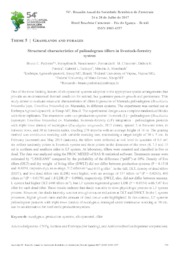Structural characteristics of palisadegrass tillers in livestock-forestry system.
Structural characteristics of palisadegrass tillers in livestock-forestry system.
Autoria: PEDREIRA, B. C. e; NASCIMENTO, H. B.; CHIZZOTTI, F. H. M.; PEREIRA, D. H.; TSCHOPE, G. L.; MOMBACH, M. A.
Resumo: One of the most limiting factors of silvopastoral systems adoption is the appropriate spatial arrangements that provide an environmental thermal condition for animal, but guarantee pasture growth and persistence. This study aimed to evaluate structural characteristics of tillers in pastures of Marandu palisadegrass (Brachiaria brizantha [syn. Urochloa brizantha] cv. Marandu), in different systems. The experiment was carried out at Embrapa Agrossilvipastoril, in Sinop-MT, Brazil. The experimental design was a complete randomized blocks with three replicates. The treatments were two production systems: livestock (L) ? palisadegrass (Brachiaria (synonym Urochloa brizantha) cv. Marandu); livestock-forestry (LF) integration ? palisadegrass pastures with triple rows (ranks) of eucalyptus (Eucalyptus urograndis, H13 clone), spaced 3 m between trees, m between rows, and 30 m between ranks, totalling 270 trees/ha with an average height of 18 m. The grazing method was continuous stocking with variable stocking rate, maintaining a target height of 30 ± 5 cm. In February (summer) and May 2016 (autumn), the tillers were collected at soil level in quadrats of 0.5 m²: six collect randomly points in livestock system and three points in the distances of the rows (4, 7.5 and 15 m) in northern and southern sides in LF system. At laboratory, tillers were counted and classified in live or dead. The data was analyzed using the PROC MIXED of SAS ® statistical software. Treatments means were estimated by ?LSMEANS? compared by the probability of the difference (?pdiff?) at 10%. Density of live tillers (DLT) and dry weight of living tiller (DWLT) did not differ between production systems (P = 0.1518 and 0.8054, respectively), an average, 512 tillers m-2 and 0.93 g tiller-1. In the fall, DLT, density of dead tillers (DDT), and live:dead tillers rate (LDR) were higher, with an average of 557 tillers m-2 (P = 0.0243), 460 tillers m-2 (P = 0.0179) and 1.8 LDR (P = 0.0986), respectively. DWLT, also, did not differ between seasons. L system had higher DLT (460 tillers m-2), but LF system registered greater LDR (P = 0.0354) with 3.07 live tiller for each dead tiller. These results indicate that shade was able to slow physiologic process in LF system process. However, the shade intensity was not enough to cause reduction at DLT and DWKT. In the L system processes, higher growth rates and the amount of dead tissue were highlighted. In this context, LF systems palisadegrass pastures with triple rows (ranks) of eucalyptus, managed under continuous stocking at 30 cm, can be an alternative for beef cattle productionsystems.
Ano de publicação: 2017
Tipo de publicação: Resumo em anais e proceedings
Unidade: Embrapa Agrossilvipastoril
Palavras-chave: Eucalyptus, Production systems, Production technology, Silvopastoral, Silvopastoral systems, Tiller
Observações
1 - Por padrão são exibidas publicações dos últimos 20 anos. Para encontrar publicações mais antigas, configure o filtro ano de publicação, colocando o ano a partir do qual você deseja encontrar publicações. O filtro está na coluna da esquerda na busca acima.
2 - Para ler algumas publicações da Embrapa (apenas as que estão em formato ePub), é necessário ter, no celular ou computador, um desses softwares gratuitos. Sistemas Android: Google Play Livros; IOS: iBooks; Windows e Linux: software Calibre.
Acesse outras publicações
Acesse a Base de Dados da Pesquisa Agropecuária (BDPA) para consultar o acervo completo das bibliotecas da Embrapa.

